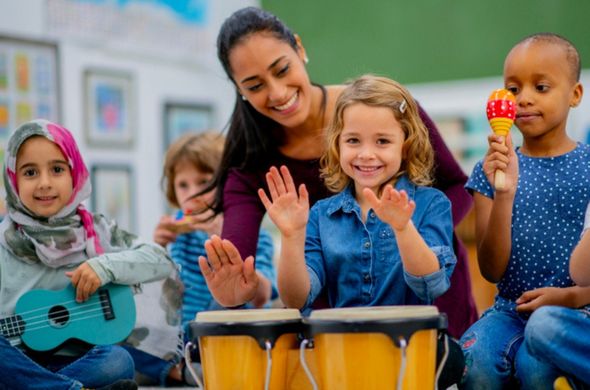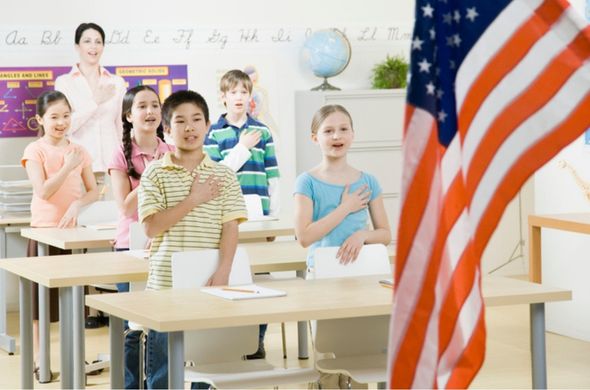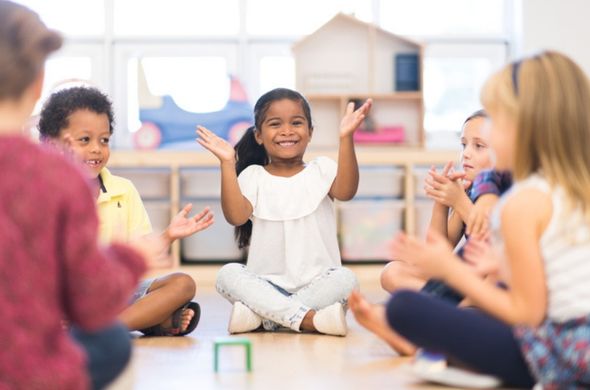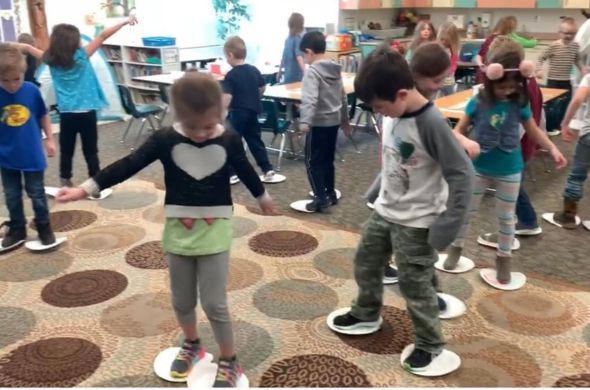
Social Studies Soundtracks: Using Music to Teach Social Studies
At first glance, social studies and music might seem like two separate subjects, but they can come together harmoniously to make learning more engaging and memorable.
Music is a valuable tool for teaching social studies because it encourages memory and movement and evokes emotions. Music is a natural part of children’s lives and makes connections to real-world learning.
Music is everywhere! It is deeply rooted in our cultures, histories, geographies, and values.
Integrating music into social studies lessons offers a dynamic and engaging way to enhance students’ understanding. By incorporating music from different eras and regions, educators can create a multi-sensory learning experience that brings the past to life and fosters a deeper connection to the material.
Because music is social, it can connect us and support a caring class environment. Here are some creative and impactful ways to integrate music with social studies to help young learners connect more deeply and meaningfully with the world around them.
Using Music to Teach History
Music acts as a historical artifact. It holds clues about the people, their values, struggles, hopes, and the time period in which it was created.
Explore Songs that Shaped History: From spirituals to jazz to patriotic songs that rallied our nation, students can examine how music has spread ideas and influenced major events.
Encourage Musical Traditions: What can musical clues tell us about people and their environments? Ask your students to reflect on how music has been part of their family traditions.
For example, my family has a “Family Song,” a special birthday song, lullabies, and other songs that have been passed down from generation to generation. What songs are important to your students’ families?
Compare Across Eras: Analyze songs from different time periods.
Ask: What has changed in the music’s tone, purpose, and message? What has stayed the same? Why do you think that is?
👉 Idea in Action: Create a class song that you sing together often. Create songs for transitions and other familiar times or celebrations. Teach your school song if you have one. Create a class playlist of historical songs, with each student contributing a song and explaining its historical significance. Let them become “History DJs!”
Using Music to Teach Geography
Music is geographically rooted. Styles, instruments, and lyrics often reflect the landscapes, climates, and cultures of their origin.
Map the Music: Play songs that mention states or cities and let students locate them on a U.S. map.
Instrument Exploration: Connect instruments with their places of origin — like the Hawaiian ukulele, Appalachian dulcimer, or Louisiana washboard.
Ask: Why might they use this instrument here? What does it say about the place? Discuss what instruments people in your family play and why they chose them. What history do they have?
For example, two of my sons chose to play the same trumpet that their dad played when he was in high school band. I chose to play the piano like my grandma because she was a concert pianist, and I wanted to be like her. I love to sing because I loved how I felt when my mom sang to me as a child, and how it has always connected us. Allow your students to share connections they may have.
World Music Travels: Celebrate holidays around the world and learn about important songs, dances, and other culturally significant practices from that country. Show pictures, maps, and videos to bring the music’s origin to life.

👉 Idea in Action: Do a musical scavenger hunt: Play a song and have students guess the place it might be from based on sound, instruments, or lyrics.
Using Music to Teach Patriotism and Civics
Music has long been a tool for civic engagement — from campaign songs to anthems to patriotic ballads.
Musical Symbols of Nationhood: Explore where and why national anthems are sung. What does “The Star-Spangled Banner” symbolize, and how does it compare with anthems from other countries?
Patriotic Song Projects: Assign patriotic songs like “This Land Is Your Land” for students to illustrate, research, or turn into visual projects like murals or paper quilt squares.

👉 Idea in Action: Let students pick a song they think would represent them as a “candidate.” What message does it send? Have them present it like a campaign rally! Teach your class “The Star Spangled Banner” to sing for a school program.
Using Music to Teach Economics
Work songs are a fascinating window into labor history and economic systems.
Music on the Job: Explore how historical workers sang songs together to express emotion and build comradery.
Music in Markets: Music can affect our moods, emotions, and feelings toward brands and products. Think about how music is used in commercials, advertisements, and even in stores.
Ask: How does music affect the way we shop? Does the type of music playing reflect the atmosphere?
Play music in class during work time and ask students to reflect on how it affects their mood and focus. Or, ask them to pay attention to the music the next time they watch a commercial, and reflect on how it makes them feel.
Jobs in Music: Discuss the music industry — composers, performers, producers, instrument makers. What roles do they play in our economy?
👉 Idea in Action: Discuss your class transition songs and how they help with motivation and procedure. Challenge students to write their own “work song” for cleaning up, working on a project, or walking in line.
Other Ideas to try:
Presidential Raps: Create a rhythm or rap to memorize U.S. presidents or states.
Musical Storytelling: Turn primary sources like letters or diary entries into song lyrics. Create musicals about U.S. history.
Global Music Gallery: Set up a gallery that features different world instruments like claves, djembes, steel drums, and explore their origins and sounds. Allow students to explore and play these instruments to demonstrate.
Celebrate Through Song: Link holidays and heritage months with corresponding music. For example, introduce spirituals or gospel for Black History Month, and mariachi or salsa for Hispanic Heritage Month.
You can also listen to happy holiday songs from around the world in December, or listen to Irish music and learn a jig for St. Patrick’s Day in March.
Integrate Music and Movement into Reading: Search for movement words in the Studies Weekly articles. Examine illustrations and respond to the emotions they evoke through movement.
Encourage students to create and perform movements based on what they have learned, such as reenacting or presenting their knowledge in small groups.
Invite students to dance a story to deepen their understanding of details, messages, settings, major events, characters, adventures, experiences, and story structure including beginning, middle, end, conflict, and resolution.

Learn Dances from Different Eras: Consider teaching a dance or two from different eras, such as The Charleston from the 20’s, The Twist from the 60’s, Disco from the 70’s, or The Moonwalk from the 80’s.
Ask: What type of dance would we like our class to be known for? Use your creativity and imagination to create something you like to do together for brain breaks.
Soundscape: Students make sounds with instruments, body percussion, or other means to help tell an event in history, explain a life cycle process, show different seasons, or create a musical representation of a vocabulary word or phrase.
Soundtracks for the Topic: Sing or listen to music that connects to the historical background or enhances the understanding of a story. For example, think of what songs would fit the American Revolution.
During our Penguin unit, we learned different ways that penguins move: sliding, waddling, diving, swimming, jumping, hopping etc. I turned on the song “Skater’s Waltz” by Émile Waldteufel and gave each of my students paper plates to stand on.
We used the paper plates like skates to help us glide around the room. We moved how the music made us feel while pretending we were penguins and would add hopping, diving, swimming, sliding along to the music. It was one of my students’ favorite memories!

Write Lyrics: Students can write new lyrics to a familiar song that relates to the content they are learning. I still remember songs we made up for the water cycle, pumpkins, and butterflies. Music sticks with us!
Echoing: Students repeat rhythms or phrases in a call-and-response style to practice vocabulary and other things they want to memorize.
Why it Matters
Music connects us across time, place, and culture. It helps students retain information and feel the content they’re learning. When we integrate music into social studies, we open doors to deeper understanding, richer empathy, and a classroom that hums with energy and purpose. Your classroom will come alive with the sound of learning!
Warmly, Debbie
 Debbie Bagley works as a Studies Weekly Teacher Advocate. Teacher Advocates are former teachers who help teachers like you implement Studies Weekly materials into their instruction. Teacher Advocates are available to provide support through email, phone call, video chat, and regularly scheduled Teacher Talk Webinars on Tuesdays and Thursdays. Teacher Advocates are only available for classroom teachers currently using Studies Weekly materials. They are not available for homeschools.
Debbie Bagley works as a Studies Weekly Teacher Advocate. Teacher Advocates are former teachers who help teachers like you implement Studies Weekly materials into their instruction. Teacher Advocates are available to provide support through email, phone call, video chat, and regularly scheduled Teacher Talk Webinars on Tuesdays and Thursdays. Teacher Advocates are only available for classroom teachers currently using Studies Weekly materials. They are not available for homeschools.